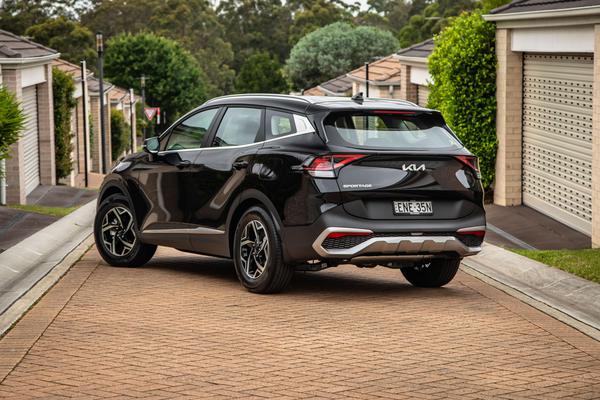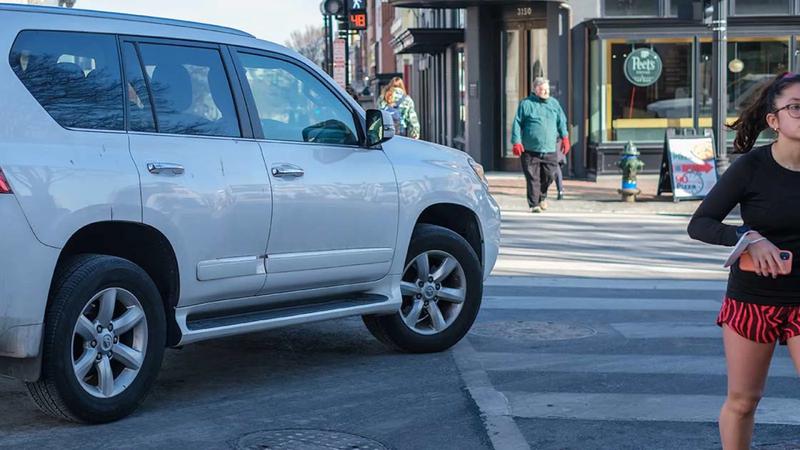It’s many months since I got a sneak peek at the latest fifth-generation Kia Sportage and, while immediately wowed by its design and high-tech cabin, I was less enthusiastic about the uninspiring outputs from the entry-level petrol version.
Not that the latest Sportage is some kind of heavyweight, but as a high-rider that stretches 4660mm in length and tips the scales at anywhere at up to 1759kg, it’s a more substantial vehicle than cars like the Toyota RAV4 and Mazda CX-5.
Either way, for a family SUV that may be called upon to ferry around five adults and gear, as well as the occasional box trailer or jet ski tow, peak power and torque of just 115kW and 192Nm to the front wheels exclusively might seem a bit underbaked.
Even the mid-spec turbocharged petrol with 132kW and 265Nm could be perceived as a tad light-on in the grunt department, despite standard all-wheel drive with this powertrain, so you can understand my enthusiasm to finally get behind the wheel of Kia’s 2.0-litre turbo-diesel equipped with a more exuberant 137kW and 416Nm of torque to all four wheels.
While there’s fair gap between the entry-level diesel and the top-spec GT-Line tested here, you can get into a new Sportage diesel for as little as $39,845 plus on-roads for the ‘S’ grade trim.
Other buyers will likely view the SX+ grade as the sweet spot in the Sportage line-up thanks to its noticeable step up in equipment over the regular SX model and that’s a perfectly fair call, but with only six-grand in it between it and the range-topper, it makes real sense for those with the means to go all the way for a thoroughly luxurious experience in the fully-loaded GT-Line.
The dual-12.3-inch curved infotainment screens will be more than enough to entice the technophiles, while the leather and suede upholstery provides equal levels of comfort and support. There’s also a full suite of the latest active safety systems and LED lighting all-round.
And, let’s not forget Kia’s seven-year factory warranty which positions the Sportage as the better bet and more prudent choice against its Hyundai Tucson cousin in the same segment.
The recommended retail price (RRP) for our Sportage GT-Line Diesel is $52,370 plus on-road costs, which in NSW brings the drive-away price to $57,280.25.
The sole option on our tester was the superb Vesta Blue premium paint seen here for an additional $520. In all, there are seven such premium paints to choose from along with Clear White and Black at no cost. For me, I’d choose Vesta Blue or Jungle Wood Green.
If you’re not sold on the diesel option, the GT-Line grade is also available with the 1.6-litre turbo petrol engine, saving $3000 at $49,370 plus on-roads but with reduced towing capacity (1650kg down from 1900kg).
Interestingly, the Hyundai Tucson Highlander 2.0D AWD with the same top-spec trim and drivetrain is priced a few hundred less at $52,000 excluding on-road costs.
Key rivals outside of its Hyundai Tucson relative and those equipped with all-wheel drive and diesel powertrains include the updated Mazda CX-5 Akera with its optional four-cylinder twin-turbo diesel ($52,380) and the Volkswagen Tiguan 147TDI R-Line ($55,290).
For those who might also want to look at hybrid technology there’s the top-of-the-range Toyota RAV4 Edge AWD Hybrid from $52,320 plus on-road costs.
2022 Kia Sportage pricing:
All prices exclude on-road costs
Sportage GT-Line highlights:
*Diesel models only
That’s on top of features carried over from lower grades:
Paint options include:
*Premium finishes add $520
**SX+ and GT-Line only
The Sportage is yet to be rated by ANCAP, though its Hyundai Tucson platform mate wears a five-star safety rating from ANCAP and Euro NCAP based on testing conducted on the short-wheelbase Euro-market model.
All Sportage variants are equipped with:
The Sportage GT-Line adds:
For more information on the safety technology on board the Sportage, go to the Kia Sportage Website or download the official Kia Sportage brochure for a description of what’s offered with each trim grade.
There are pluses and minuses when you climb into the top-spec Sportage, especially if you’re considering handing over $57,000 of your hard earned.
The perforated leather/suede-look upholstery looks and feels almost European except for the lack of rear-seat bolsters and not quite enough support up front. Otherwise it’s perfectly comfortable, especially on longer journeys.
Likewise with the super-sized dual infotainment screens. They’re flash, certainly large enough, and are ergonomically positioned for easy reach, as well as offering good graphics and fast responses – but they just don’t have the crisp, glassy, or premium appearance of those you find in genuine luxury marques.
It’s a similar story with the cabin in general. Plenty of soft-touch surfaces and quality piano black inserts with knurled dials help to separate the GT-Line from its lower-grade siblings, but the overall finish is tarnished by several cheap-looking hard plastic panels compared with those used by the likes of Mazda and Subaru in the same segment.
These days, we’re used to wireless CarPlay and while the base Sportage S is equipped with this tech, all other grades including the flagship GT-Line have to settle for the wired version. Not ideal when you’re paying so much more.
The new-look cabin also means minimal buttons, dials and clutter for the latest Sportage, and along with those dual screens there’s a terrific touch panel below that switches seamlessly between the air-con and media functions. Mind, you’ve still got the convenience of two small dials that double as both volume/tune and temperature controls which is endlessly better than searching through various menus like so many manufactures have adopted of late.
Perhaps I’ve been a tad harsh on the quality aspects of Sportage’s cabin, but again, things like the imitation wood on the front door cards and cheap plastics on rear doors are instances of things that could have been executed better.
However, there’s no shortage of kit on board. In fact, there’s little if anything you don’t get in the range-topping GT-Line.
The eight-speaker Harman Kardon audio is from a quality brand and offers good clarity throughout the highs and lows, while heated and cooled front seats are commensurate with its status.
Where the Sportage really starts to shine is in the space and storage department. Up front, there’s a properly large compartment for phones, wallets and keys that also doubles as a wireless phone charger along with USB-A, USB-C and 12V ports.
Behind are two customisable cup holders which can also retract to free up more space for things like sunnies and face masks – suffice to say, it’s more than ample.
Thanks to Kia Australia taking the long-wheelbase version of the Sportage exclusively, rear-seat legroom and general comfort is excellent for all three seat positions due mostly to the relatively low transmission tunnel.
Moreover, there are two USB charge ports built into each front seat, as well as a small centre armrest with dual cupholders. It’s a relatively simple unit with no extra storage compartment like some rivals, though there’s proper seat pockets and door bins for water bottles.
There’s 543 litres of boot space with the rear seats in uses, and a relatively wide aperture with high floor for easy loading – drop the second row and that raises to 1829L.
There’s also the convenience of a full-size spare under the floor along with a couple of small underfloor cubbies if you need extra security.
However, while the rear seats can be remotely folded from the boot, they don’t exactly fold flat which can be slightly inconvenient depending on what you’re hauling.
Our top-spec Sportage GT-Line tester came with the 2.0-litre four-cylinder turbo-diesel making 137kW of power at 4000rpm and 416Nm of torque between 2000rpm and 2750rpm, sent to an on-demand all-wheel drive system via an eight-speed automatic transmission.
Combined fuel consumption is rated at 6.4L/100km – that said, I was getting reads of 10.3L/100km with mostly suburban driving, so I’m not surprised. I suspect the average punter would get close to official claims with a wider spread of conditions.
With the Sportage Diesel you also get Multi-Terrain Mode that allows the driver switch between Snow, Mud and Sand modes for the AWD system.
Buyers can also choose the GT-Line with a 1.6-litre four-cylinderturbo engine (saving $3000), which by comparison develops 132kW at 5500rpm and 265Nm from 1500rpm to 4500rpm, using a seven-speed dual-clutch transmission with the same on-demand AWD system.
Fuel efficiency for the petrol is a claimed 7.2L/100km (combined) and down to 6.3L/100km for longer-range cruising.
When it comes to towing it’s the diesel Sportage that gets the heavier tow rating at 1900kg (braked), which, is the same as the manual petrol version. Choose either petrol engine with automatic transmissions and the tow rating drops to a maximum of 1650kg. However, all Sportage model variants have a maximum tow ball download of 100kg.
The 416Nm torque output in our diesel tester was enough to get me mildly excited, at least initially. There’s no substitute for low-down pulling power, especially knowing the diesel engine version adds 116kg on top of the petrol variant.
While it’s certainly punchy off the line thanks to minimal lag, it’s no firecracker. Somehow, I expected a tad more shove from the range-topping Sportage.
Don’t get me wrong, it’s not really a gripe, just me wanting about 50Nm more torque to play with. Perhaps that’s an opportunity for Kia to up the ante with a more premium variant, complete with more grunt under the bonnet?
That said, for its 2.0-litre displacement this powertrain delivers worthy refinement under a smoothly applied throttle. It’s only when you really give it the beans does that dreaded diesel clatter make itself known inside the cabin, but even then it’s not anything egregious.
Kia and Hyundai develop their own transmissions and the proven eight-speed auto used here is an outstanding bit of engineering, offering smooth shifts and well-spaced gear ratios which is commensurate with the overall refinement of this new-generation Sportage.
Kia has equipped the entire Sportage line-up with its drive selector system which allows drivers to choose between Eco, Normal, Sport and Smart modes that effectively customise throttle response and transmission shift points.
While I enjoyed the sharper response in Sport, I found myself settling in on Smart mode given I figured the car’s computers would give me the optimum balance between performance and efficiency, which was largely the case, unless I really needed to leap off the line at the traffic lights, in which case I switched to Sport.
Our GT-Line tester was equipped with 235/55 R19 Nexen tyres from Korea, so plenty of sidewall to cushion those larger bumps, though not quite the level of compliance I would have liked.
Kia has a track record of locally tuning suspension and while COVID-19 certainly presented challenges with the new Sportage, it features a bespoke tune for our conditions… but perhaps not as convincing as previous tunes.
While larger bumps and potholes are effectively ironed out, it’s the smaller stuff that can produce a sharper response from the suspension, so at times it felt a tad busy for my liking, as though the dampers had been tuned with a skew towards tighter body control rather than outright bump-absorbing comfort.
That said, there’s still some body roll when carrying moderate speed through tighter bends, which I put down to the larger proportions of the new model and extra weight of the diesel powertrain over the petrol.
It also amplified what I believe to be a lack of side bolster built into the design of the front seats, as I found myself sliding around more often than not during mundane suburban driving, which took me by surprise as they look to have sufficient support, at least aesthetically.
The Kia line-up is covered by a factory-backed seven-year, unlimited-kilometre warranty with seven years of capped-price servicing.
Service intervals are 12 months or 15,000km (10,000km for the 1.6T AWD variants) with an all-up outlay of $3571 over seven years or 105,000km for the 2.0D AWD – $350, $541, $424, $784, $382, $684 and $406.
By way of comparison, the first five year pre-paid service package with Kia costs $2481, while sister brand Hyundai offers the same length package for $1875, bringing the cost down to an average of $375 per visit.
I know the design can be polarising, but I was sold on the latest-generation Sportage from the moment I got a sneak peek at a Jungle Wood Green GT-Line a few weeks before it officially launched here.
It’s more revolutionary than evolutionary and has significantly elevated the brand’s cachet (along with every other new Kia model) in the eyes of many here in Australia.
But it’s not perfect and it’s not cheap. There are some shortcomings in the top-spec GT-Line Diesel which have dampened my overall enthusiasm for the range-topping variant.
That said, the overall package is attractive and enticing but it’s not the sweet spot in the range, I’d suggest the Sportage SX+ represents the best value for money without sacrificing much in the way of kit.
Click the images for the full gallery
MORE: Everything Kia Sportage




